26 Types Of Cactus For Your Garden (With Pictures) Indoor, Outdoor
With the abundance of free time during this period, many people are finding solace in nurturing plants. One such trend is growing cactus and succulents, which have gained popularity due to their low maintenance requirements and ability to thrive with minimal attention. Not only do they produce vibrant flowers that can brighten up any space, but they also offer a sense of accomplishment and connection to nature.
If you’re new to the world of cacti or simply want to learn more about these fascinating plants, this article will provide an comprehensive overview of the different types of cactus, their unique characteristics, and why you might consider planting one in your home or garden.
Cacti have been a staple of many cultures for centuries, with over 1,500 species found across the globe.
They are characterized by their thick, waxy stems that store water, allowing them to survive in arid environments with minimal rainfall. From the majestic saguaro cactus, which can grow up to 60 feet tall, to the tiny powder puff cactus, there’s a wide variety of species to choose from.
Some popular types of indoor cacti include the Christmas cactus, fairy castle cactus, star cactus, and barrel cactus.
These plants are perfect for those who want to add some greenery to their home without sacrificing too much space or maintenance. Outdoor enthusiasts can also enjoy a range of cacti, from the towering saguaro to the prickly pear, which produces edible fruits.
Despite their reputation for being tough and resilient, cacti are surprisingly fragile and require proper care to thrive. They need adequate sunlight, moderate watering, and fertilization to promote healthy growth.
With a little patience and attention, these plants can become a beloved addition to any home or garden.
What is a cactus?
While many people are familiar with the unique aesthetic appeal of cacti, fewer may be aware of their botanical classification. With over 170 variants and 2,000 species, cacti are a diverse group of plants that don’t fit neatly into traditional categories like trees, flowers, or herbs. Instead, they belong to the family Cactaceae and share certain characteristics with succulents, including the ability to store water in their stems for extended periods.
However, this is where the similarities end, as cacti have some key differences that set them apart from other succulent plants. For example, while they may produce flowers, they are not flowering plants in the classical sense. Similarly, while they can grow tall without woody stems, they don’t meet the typical definition of a tree. The name ‘cactus’ itself comes from the Latin word kaktos, meaning spiky plant, which gives you an idea of their distinctive physical characteristics.
When it comes to finding and purchasing cacti and succulents, there are plenty of options available – check out our related article for more information.
Cactus facts
Beyond the fascinating facts already shared, there are many more intriguing aspects of cacti that warrant attention. For instance, their spines serve a dual purpose: they protect these plants from predators and provide insulation during periods of severe drought. Additionally, the ribbed and waxy texture of their stems plays a crucial role in retaining water, allowing them to thrive in arid environments.
Cacti have adapted to compensate for the lack of leaves by engaging in photosynthesis at night, utilizing their stems as the site of this process. This unique characteristic sets them apart from other plants that undergo photosynthesis during the day.
It’s also worth noting that not all cacti are characterized by sharp spikes; some species, like forest cacti, feature bristles instead.
Furthermore, while wild cacti can live for over a hundred years, their indoor counterparts typically have a much shorter lifespan of around 15 years.
Cacti are native to Mexico, Brazil, and other parts of Central and Latin America, with their range extending into British Columbia and Patagonia. This remarkable diversity is a testament to the resilience and adaptability of these incredible plants.
Identifying the Cactus Family
Cacti, a fascinating group of plants, can take many forms, including tree-like structures, shrubs, vines, or even epiphytes that thrive without soil. One characteristic that sets cacti apart is the presence of ‘spines,’ which are actually modified leaves designed to conserve water and protect the plant from its environment. These remarkable adaptations enable cacti to survive in arid conditions, where evaporation can be a significant threat.
In addition to their unique ‘spines,’ many cacti species boast vibrant flowers that bloom at various times of the year, adding to their natural beauty. With their diverse shapes and sizes, cacti are truly one of nature’s wonders.
How Cacti Survive With No Water
In arid desert environments where rainfall is scarce, cacti have evolved to thrive in these conditions by developing unique adaptations. Many species of cacti are classified as xerophytes or succulents, able to survive with minimal water intake. One key mechanism that enables cacti to conserve water is Crassulacean acid metabolism (CAM), a process distinct from traditional photosynthesis.
CAM occurs at night, allowing plants to store carbon dioxide and release it during the day, thereby minimizing water loss through transpiration.
Uses of Cacti as Food and Medicine
Cacti have been a vital source of sustenance and medicinal relief for indigenous communities dating back centuries. From Native American tribes to Hispanic pioneers settling in the Americas, these ancient plants have played a significant role in daily life. As some cacti species possess psychoactive properties, it’s crucial to accurately identify the types to ensure their safe consumption.
The fruit and seeds of certain cacti, such as those belonging to the Opuntia genus, were particularly valued for their edibility.
Common Cacti of the Cactus Family
Cacti are diverse and widespread, with many species belonging to the Opuntia family. The desert Christmas cactus (Opuntia leptocaulis), for instance, is a distinct species that should not be confused with the more commonly known Christmas cactus. Other notable members of this family include the agave cactus (Leuchtenbergia principis) and the prickly pear (Opuntia).
The barrel cactus (Ferocactus echinocactus), saguaro (Carnegia giganta), rose cactus (Pereskia grandifolia), ocotillo (Fouquiera splendens), and mistletoe cactus (Rhipsalis baccifera) are just a few examples of the many unique species that fall under this category. These plants have evolved to thrive in a range of environments, from arid deserts to lush forests.
The Cactaceae Family
The cactus family has been thriving for centuries, with a unique set of adaptations that enable them to flourish in challenging environments. As explorers ventured into the Americas, they brought back numerous cacti species, which are now cultivated in greenhouses and homes across Europe. Despite being widely distributed, many cacti species still thrive best in their natural habitats – the arid deserts of the Americas, where they can be found in abundance.
The difference between succulents and cacti
While the terms ‘succulent’ and ‘cactus’ are often used interchangeably, there’s a subtle distinction between the two. Succulent refers to any plant that exhibits certain characteristics, including drought tolerance, fleshy stems or leaves, and the ability to store water in its stems. This umbrella term encompasses not only cacti but also other plants and trees that share these traits. In contrast, ‘cactus’ is a botanical name specifically referring to plants belonging to the Cactaceae family.
Two key differences set cacti apart from succulents are their lack of leaves – instead, they have long stems capable of storing more water – and the presence of areoles or branch-like structures where flowers bloom. Succulents, by contrast, typically feature fleshy leaves.
Types of indoor cactus
Within the comfort of our homes, indoor cacti bring a touch of natural elegance. Strategically placed near windowsills, bedrooms, or bathrooms, they silently work to purify the air as we sleep. Here’s a selection of stunning indoor cactus varieties you can cultivate in your own space.
Christmas cactus (Schlumbergera)
The ‘Christmas Cactus’ earns its name due to its unique blooming period, which spans from November to January. This remarkable coastal cactus, native to Brazil, is known for its ability to thrive in unexpected environments – often growing wildly atop large trees or rocky outcroppings. As the winter months unfold, it produces an array of vibrant flowers in shades ranging from soft pink and creamy white to bright yellow and rich purple hues.
Fairy castle cactus (Acanthocereus Tetragonus)
The Fairy Castle Cactus boasts an enchanting appearance, with stems that rise from the same pot in varying heights, evoking the majesty of a medieval fortress. Despite its whimsical nature, this species is characterized by slow growth rates and infrequent flowering. At its maximum height, the cactus can reach up to 6ft tall, offering a striking presence in any garden or indoor setting.
Star cactus (Astrophytum asterias)
The Sea Urchin Cactus, also known as the Starfish Cactus due to its unique, concave stems, is an ideal choice for indoor gardens. Reaching a maximum height of just 6 inches, this cactus is compact and doesn’t require extensive pruning or support. Its vibrant yellow blooms are particularly striking, adding a pop of color to any room. This low-maintenance succulent is perfect for those new to gardening or seeking a stylish, space-saving addition to their indoor spaces.
Barrel cactus
The Barrel Cactus, with its distinctive barrel-like shape, is characterized by its ability to spread out rather than growing vertically. This unique feature earns it another nickname – the ‘Mother-in-Law’ Cushion. As a desert dweller, it thrives in full sun and can survive with minimal watering, making it an attractive option for those looking to add some low-maintenance charm to their garden.
Old lady cactus (Mammillaria hahniana)
The Old Lady Cactus is an ideal choice for novice gardeners due to its low-maintenance requirements. Unlike other plants that demand regular watering, this cactus thrives even in its initial growing stages without excessive hydration. Its unique characteristics include white spines that cover its entire surface, earning it the endearing name of Old Lady.
Moon cactus (Gymnocalycium mihanovichii)
One of the most charming features of this cactus is its vibrant, red-orange blooms that resemble a full moon in shape. Not only do they add a pop of color to dull indoor spaces, but they’re also a great conversation starter. This hybrid cactus is actually a product of grafted cacti and makes an excellent choice for newcomers to the world of succulents. While it’s a delight to have around, it does have one drawback: its relatively shorter lifespan compared to other types of cacti.
Lady Finger cactus (Mammillaria elongata)
The Lady Finger Cactus, also known as the gold lace cactus due to its delicate, golden yellow spines, is a unique species that thrives in well-cultivated environments. Its distinctive feature lies in its ability to produce five slender, tube-shaped stems from a single pot, earning it the nickname ‘Lady Finger’. Measuring only six inches in height, this diminutive cactus is topped with small, white blooms during the spring season, adding an extra layer of charm to its already striking appearance.
African milk tree cactus (Euphorbia trigona)
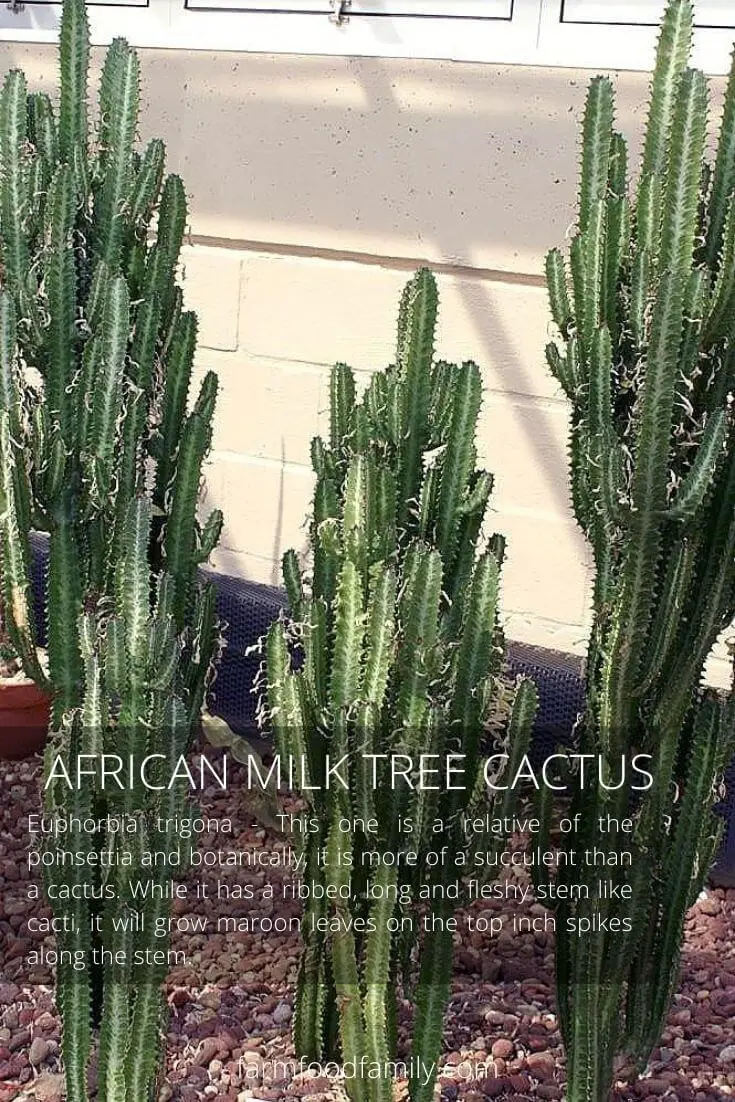
While not as well-known as its cousin the poinsettia, the related Echeveria succulent boasts a unique appearance. Its elongated, fleshy stem bears a striking resemblance to cacti, yet it produces vibrant maroon leaves on the top spikes along the stem. Interestingly, human contact with this plant can cause skin irritation and redness, making it essential to handle with care.
Parodia
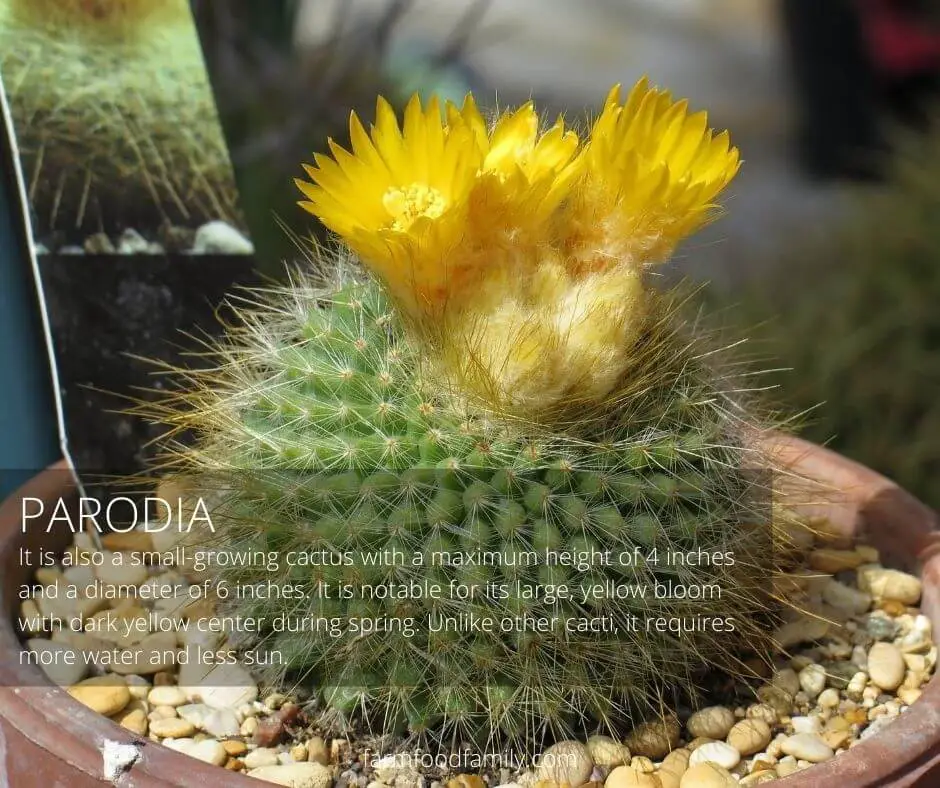
This species of cactus is characterized by its compact growth habit, reaching a maximum height of just 4 inches and a diameter of approximately 6 inches. One of its most striking features is its vibrant yellow bloom, which is accompanied by a dark yellow center during the spring season. What’s noteworthy about this particular variety is that it has different growing requirements compared to other cacti. It thrives in environments with more moisture and less direct sunlight.
Bunny ear cactus (Opuntia microdasys)
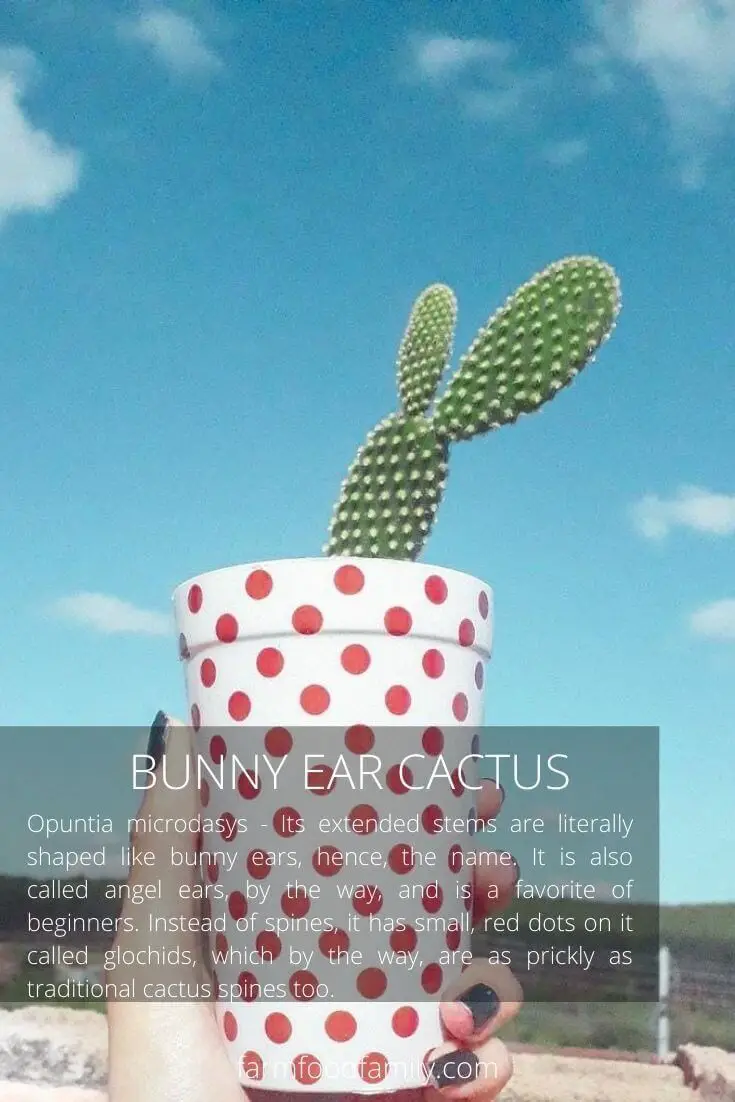
The ‘angel’s ears’ plant, also known as bunny ear cactus, is a beginner-friendly favorite. Its unique stems take on an unmistakable shape reminiscent of rabbit ears, earning it its endearing nickname. A notable characteristic of this species is the presence of small, red glochids instead of traditional spines. These tiny, yet surprisingly prickly, protrusions provide a subtle defense mechanism for the plant.
Feather cactus (Mammillaria plumosa)
The Euphorbia trigona, also known as the candelabra euphorbia, is characterized by its unique feature: small, white bristles that cover the entire plant from top to bottom. These soft-looking ‘feathers’ serve a crucial purpose – they conceal the plant’s sharp, prickly spines, making it essential to exercise caution when handling this unusual plant.
Saguaro cactus
The majestic cactus, native to the Sonoran Desert which spans from Baja California to Mexico, is a surprisingly low-maintenance indoor plant due to its peculiar growth pattern. During its first eight years of life, it grows a mere half-inch, making it an ideal choice for indoor spaces. Interestingly, this remarkable plant can live for over 200 years, rivaling the longevity of the ancient Saguaros found in Sonora, which have been known to thrive for centuries.
Blue columnar cactus (Pilosocereus Pachycladus)
The Peruvian Apple Cactus, with its striking blue-green stems and delicate grey spines, is a popular choice among indoor gardening enthusiasts. Despite being a low-maintenance option, this cactus is ideal for beginners looking to add some visual interest to their space. To thrive, it requires bright, cool lighting conditions. However, it’s essential to exercise caution when handling the Peruvian Apple Cactus, as its spines can cause skin irritation in some individuals.
Easter cactus (Schlumbergera gaertneri)
While many people associate cacti with sharp spines and drab colors, this particular species defies those expectations. Its unique stems resemble succulent leaves, a departure from the typical cylindrical shape. Furthermore, these stems are adorned with vibrant, full-bodied blooms that burst forth in shades of deep pink and yellow-white during early Spring, coinciding beautifully with Easter.
Even when not in bloom, the plant’s segmented, deep-green stems provide a stunning visual display, making it a standout even without the added flair.
Bishop’s cap cactus (Astrophytum myriostigma)
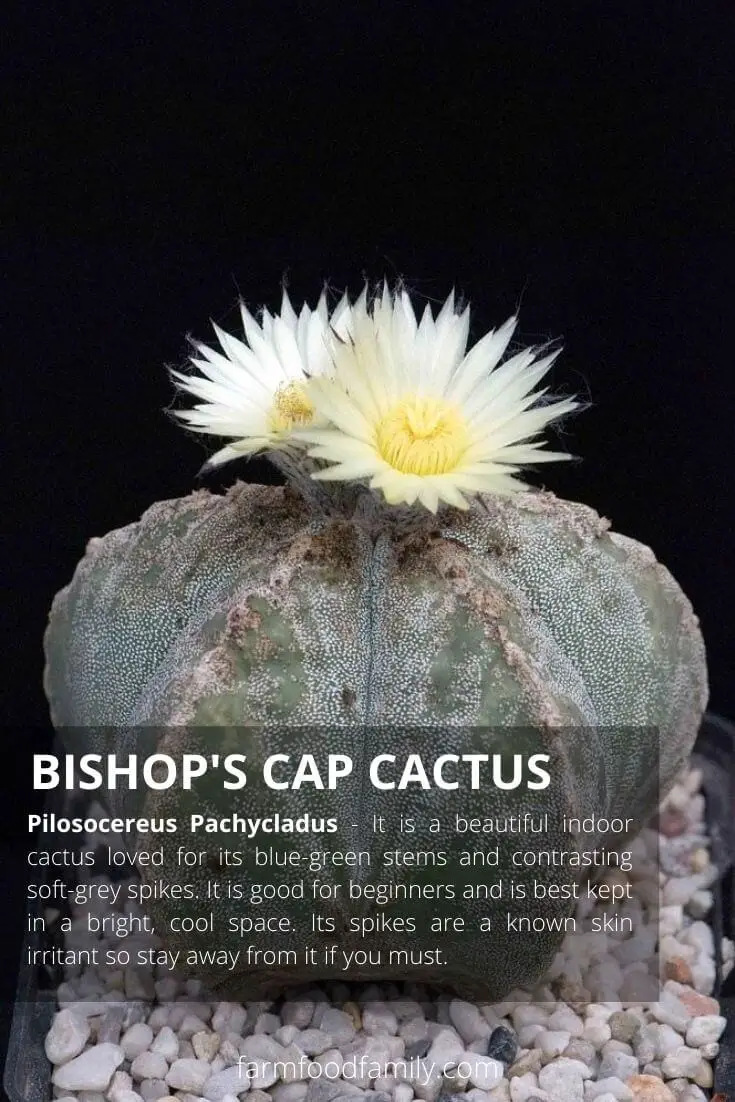
The Prickly Pear Cactus bears an uncanny resemblance to the mitred cap worn by Roman Catholic bishops. This unassuming cactus makes for a fantastic indoor plant due to its slow growth rate and low water requirements. While it won’t produce showy blooms frequently, you can expect small, bright yellow flowers to briefly appear in the spring, adding a touch of warmth and vitality to your interior space.
Powder puff cactus (Mammillaria bocasana)
In its natural habitat, this striking cactus can be found thriving in Central Mexico, where it often grows beneath bushes or nestled among rocks. Noted for its remarkable ability to produce small offsets around the mother plant, this species is renowned for its rapid growth rate. The plant’s blue-green stems are a striking feature, complemented by vibrant reddish spikes and delicate white bristles.
As spring arrives, the cactus bursts into bloom, producing a dazzling display of yellow, white, pink, and red flowers that add to its natural beauty.
Balloon cactus (Notocactus magnificus)
A peculiar aspect of this rare cactus is that it’s often sold as seeds rather than established plants. Its unique appearance features a rounded, blue-green body adorned with bright golden yellow spines. Notably, it can propagate through offsets that branch off from the mother plant or grow independently. When conditions are right, it produces soft yellow flowers in the spring and summer seasons.
Types of outdoor cactus
While some species of cacti may be too prickly, fast-growing or tall to thrive indoors, others are well-suited for outdoor cultivation. In fact, many types of cacti are staples in xeriscaping designs, not only because they can tolerate the hot desert sun but also because they produce vibrant, show-stopping blooms that add a pop of color to any landscaping scheme.
Arizona barrel cactus (Ferocactus wislizeni, the fishhook barrel cactus)
The fishhook barrel cactus, also known as Ferocactus wislizenii, is a unique and striking succulent that gets its name from its distinctive appearance. Its barrel-shaped body is covered in long, thin spines that resemble fishhooks, giving it a rugged and imposing look. The stem of the plant is segmented with thick, leathery ridges that add to its texture and visual interest. As the seasons change, this cactus produces cup-shaped flowers in the spring, followed by yellow berries in the summer.
Whether used as a statement piece or incorporated into a larger landscape design, the fishhook barrel cactus is sure to draw attention with its one-of-a-kind appearance.
Queen of the night cactus (Epiphyllum oxypetalum)
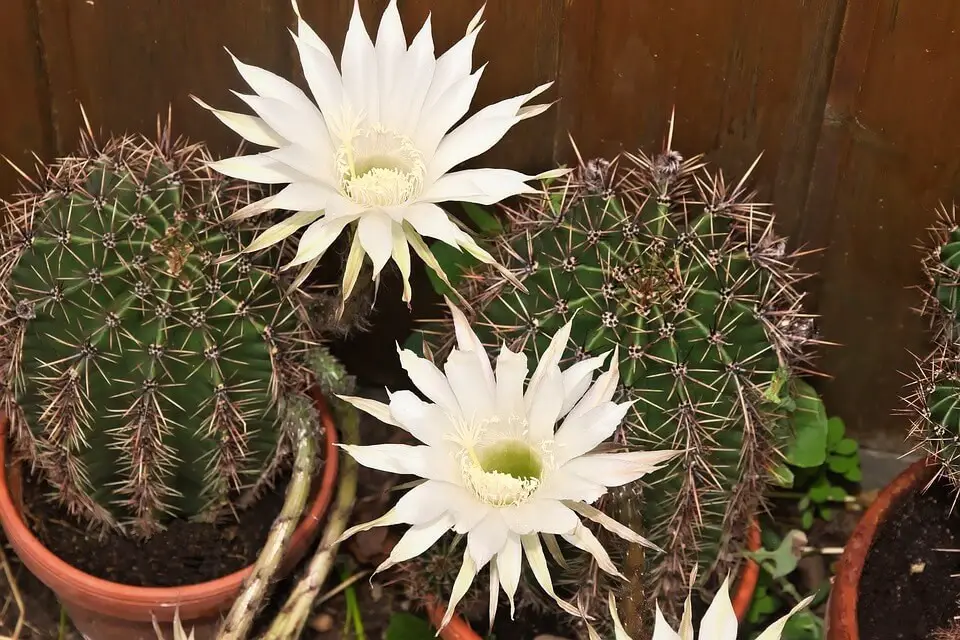
The Night-Blooming Wonder: A Closer Look at the Dutchman’s Pipe Cactus
The Dutchman’s Pipe cactus earns its distinctive name from its remarkable, pipe-shaped stem. Native to Brazil, this unique species typically thrives in the shade of large trees.
But what truly sets it apart is its extraordinary habit of blooming white flowers exclusively under the cover of night.
Strawberry cactus (Mammillaria dioica, California fishhook cactus)
This unique plant is characterized by its distinctive cylindrical stems, which can reach heights of up to four feet as they mature. As it grows, the main stem gives rise to a multitude of smaller stems, ranging from 15 to 100, creating a lush and dense display. In the spring, it produces delicate pink flowers, while occasional blooms may also appear in the fall.
Prickly Pear cactus (Opuntia)
The Opuntia genus comprises a diverse range of species, including the well-known Indian fig prickly pear and beavertail prickly pear. Interestingly, after shedding its spines, this cacti type develops prickly glochids, reminiscent of bunny ears. As the seasons change, you can expect to see vibrant yellow, pink, and purple flowers blooming during spring or fall. For more information on caring for these unique plants, consider reading our related article Propagating Prickly Pear Cactus.
The old man cactus (Cephalocereus senilis)
The majestic orchid known for its striking white, silk-like coating on its stem is native to Eastern Mexico. This unique characteristic sets it apart from other species. One of the most fascinating aspects of this orchid is its slow growth rate, requiring 10-20 years before it produces its first blooms. What’s even more remarkable is that when it does bloom, it only reveals its beauty under the cover of darkness, making each night a special occasion.
Golden barrel cactus (Echinocactus grusonii)
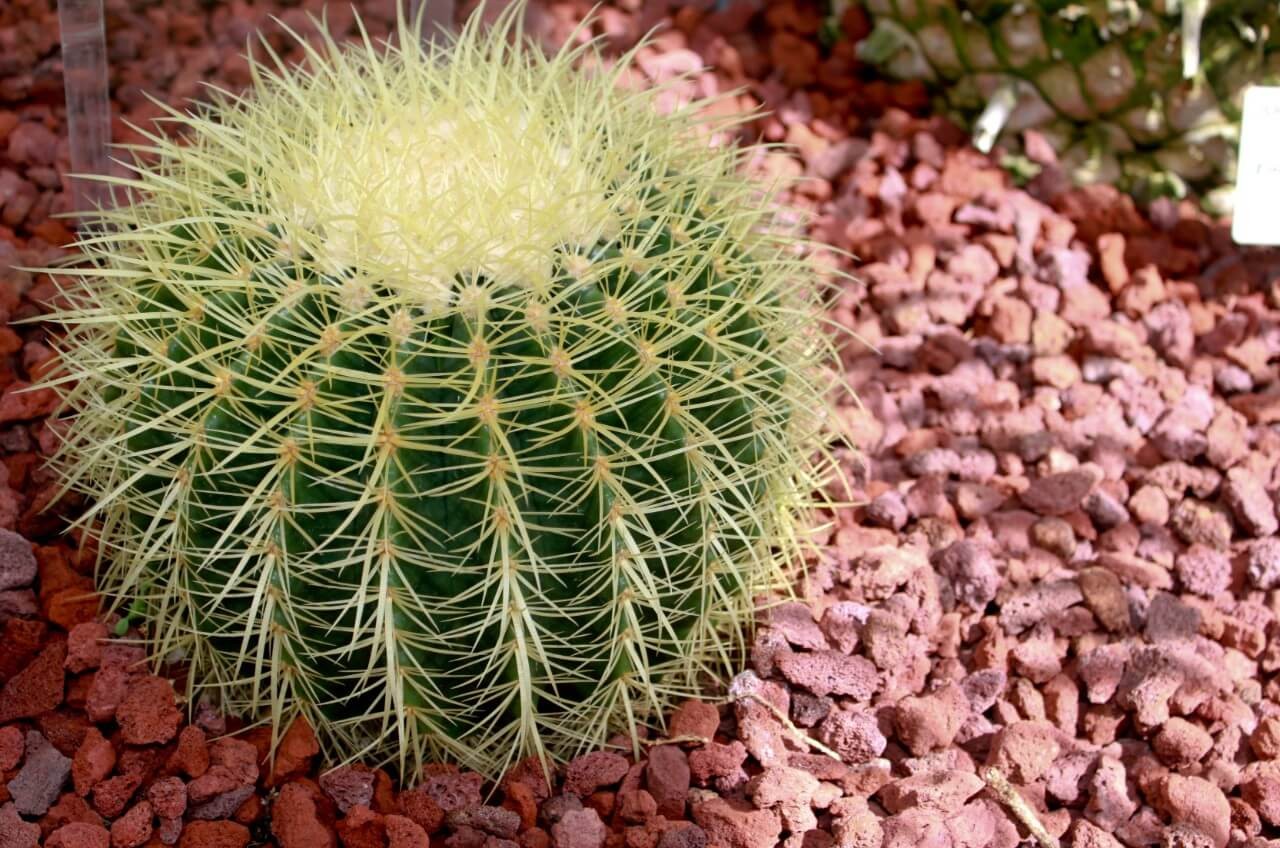
As the Juniperus monosperma matures, it assumes a barrel-like shape, measuring approximately three feet tall and wide. The tree’s distinctive characteristic is its bright golden-yellow foliage, which grows in dense clusters along the plant’s ridges. This unique feature gives the plant its prickly texture.
Types of cold-hardy cactus
While many species of cacti require direct sunlight, these particular types can adapt to a range of light conditions, including partial shade. Moreover, their slow growth rate makes them suitable for both indoor and outdoor settings. Notably, they are also capable of tolerating some frost and cooler temperatures, providing added flexibility in terms of planting location.
Hedgehog cactus (Echinocereus engelmannii)
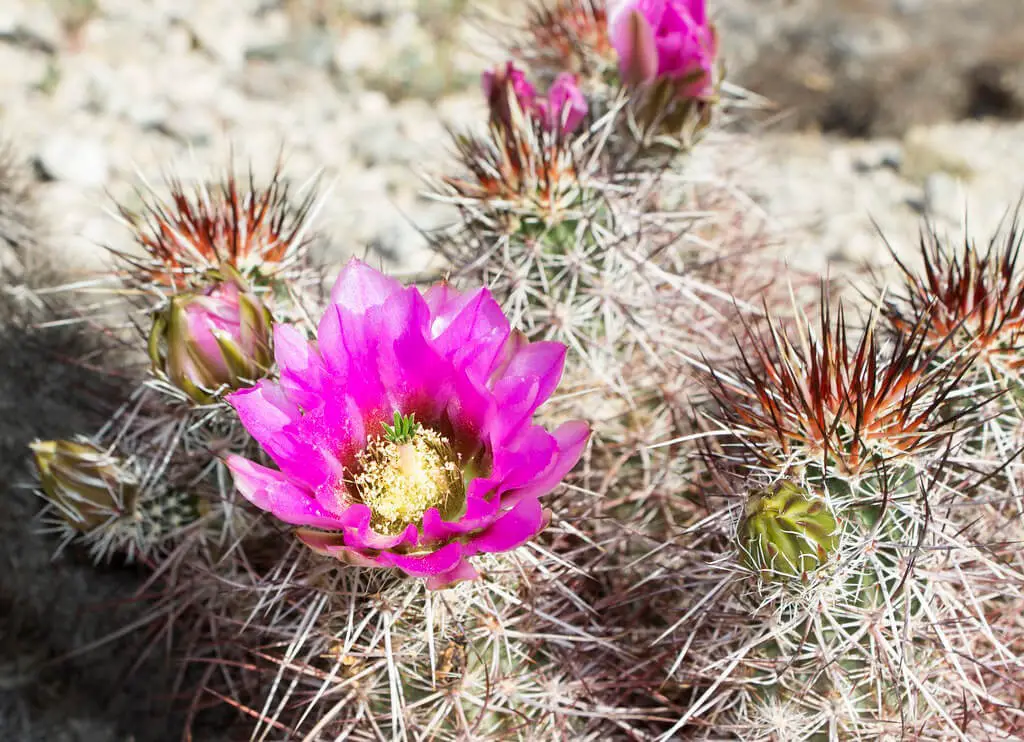
This prickly plant, also known as the ‘hedgehog’ cactus, is characterized by its slow growth rate and low-lying habit. Its unique feature is the short, spiky stems that resemble hedgehog quills. These stems typically grow in clusters, ranging from a mere ten to a maximum of sixty stems per group. One of the most notable aspects of this cactus is its vibrant pink blooms that appear during the spring season, adding a pop of color to the surrounding landscape.
Club cholla (Grusonia clavata)
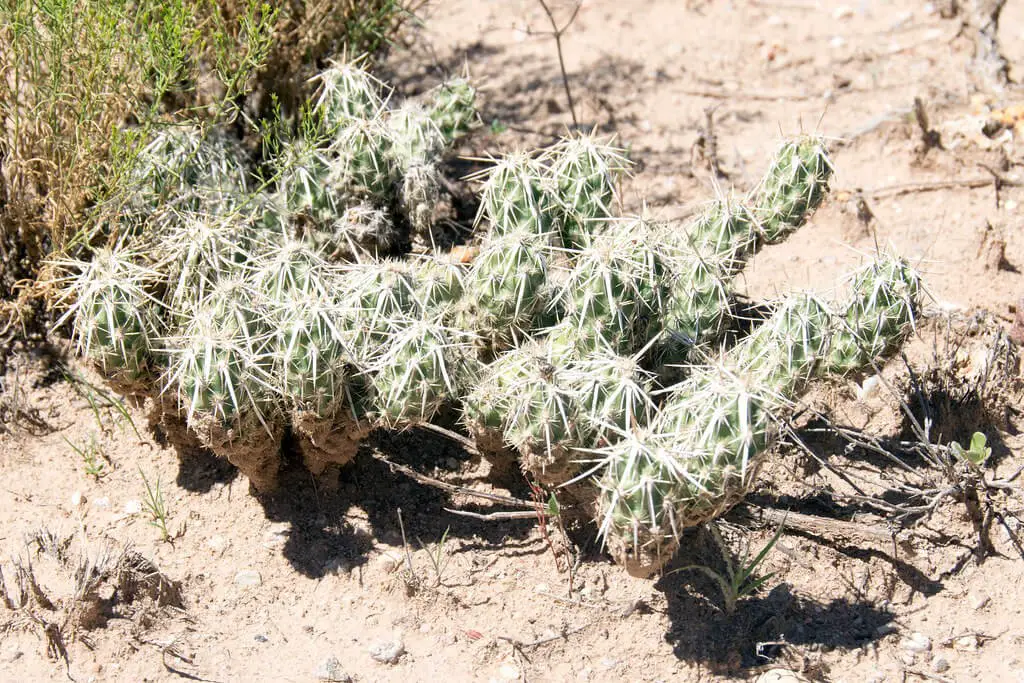
The Clustered Coral, despite its name, appears to be a plant with a rounded stem supported by sharp spines running along its length. This peculiar specimen thrives in abundance of sunlight but demands less moisture. As the seasons change, it bursts forth with vibrant orange or green blooms in the spring and fall. Interestingly, this species boasts over 20 distinct varieties, showcasing its remarkable diversity.
Beehive cactus (escobaria vivipara)
This unique succulent is renowned for its remarkable longevity, despite its compact stature. Its peculiar appearance stems from its ability to form sprawling colonies resembling beehives. The ‘Creeper’ gets its name from this characteristic growth habit. While it may be easily mistaken for Coryphantha robusta due to their similar appearances, the distinctive purple or magenta blooms of the Creeper set it apart, offering a visually striking display.
Frequently Asked Questions
While exploring the world of cactus care, it’s essential to address any lingering questions and misconceptions. One key area to consider is the specific light and temperature requirements for different species of cacti. For instance, can they withstand cold temperatures or thrive in shaded environments? Additionally, many people are curious about the symbolic meanings behind these prickly plants. By answering these FAQs, you’ll be well-prepared to bring a cactus into your life.
Is a cactus a tree or a plant?
While we touched on the basics of cacti earlier, let’s dive deeper into what sets them apart from trees. Botanically speaking, cacti are indeed plants, classified under the family Cactaceae. However, despite their potential for impressive height, they don’t share many characteristics with trees. Unlike trees, cacti lack woody stems, robust foliage, and solitary leaves. Moreover, they don’t have branching structures like trees do.
Instead, they’ve evolved unique features that enable them to thrive in arid environments.
Cactus meaning and symbolism
While often misunderstood as a prickly and resilient plant, the cactus embodies more than just endurance. Its unique ability to thrive in harsh environments, such as arid deserts, has led to its symbolic representation of resilience and adaptability. Moreover, despite its tough exterior, it’s capable of blooming vibrant flowers in stressful conditions, exemplifying a remarkable capacity for inner beauty and innocence.
The cactus’s soft interior, where stems store water, further reinforces this duality, highlighting the importance of looking beyond surface-level appearances to discover true character.
Can cacti grow in low light?
While some cacti species can adapt to low-light conditions, many require at least four hours of direct sunlight to thrive. As a result, they are frequently housed indoors where they can benefit from a combination of natural and artificial lighting, which provides the necessary illumination for optimal growth.
Can cacti grow in shade?
Cacti typically thrive when exposed to sunlight, but some species can adapt to shaded conditions. During the winter months, it’s common to bring them indoors where they require 10-14 hours of indirect artificial lighting to mimic their natural environment. While most cacti prefer bright light, there are a few cold-hardy species that can tolerate partial to full shade.
Can cacti survive in winter?
While it’s true that cacti are often characterized as sun-loving plants, many species are actually winter-hardy and can thrive in cold temperatures. In fact, some cacti can tolerate temperatures as low as -20 degrees Fahrenheit, making them surprisingly resilient to the cold. However, even these hardy species have limitations when it comes to frost and ice.
While they may be able to survive a brief spell of freezing conditions, prolonged exposure or excessive frost can still have negative effects on their growth and development over time. This might manifest as stunted growth or an inability to produce flowers for a period.
Conclusion
While it’s true that cacti are incredibly resilient and adaptable, understanding the unique characteristics of each species is crucial. Some cacti thrive in the shade, while others can tolerate frost and temperatures as low as 15 degrees Celsius. On the other hand, some species are sensitive to skin irritation or require specific growing conditions. Knowing the types of cacti you’re working with is essential for ensuring their survival and promoting healthy growth.
Additionally, if you’re particular about blooms or want to create a thriving cactus garden, it’s vital to research and understand the distinct needs of each species. Ultimately, embracing the diversity of cacti is key to fostering a deeper appreciation for these remarkable plants.
Related Posts
For succulent enthusiasts, it can be frustrating to encounter issues with their plants’ growth or overall health. Fortunately, by understanding how to care for specific types of succulents, you can overcome these challenges and enjoy the beauty and benefits they bring to your space. This includes learning about the unique needs of popular species like String of Pearls, Peperomia Graveolens ‘Ruby Glow’, Rhipsalis cereuscula (Coral Cactus), and Crassula muscosa ‘Watch Chain’.
Whether you’re looking to grow these plants in containers or overcome common issues like succulent death, understanding the proper care techniques is key. By exploring topics such as soil selection, watering habits, and lighting requirements, you can develop a deep appreciation for these fascinating plants and ensure they thrive under your care.






